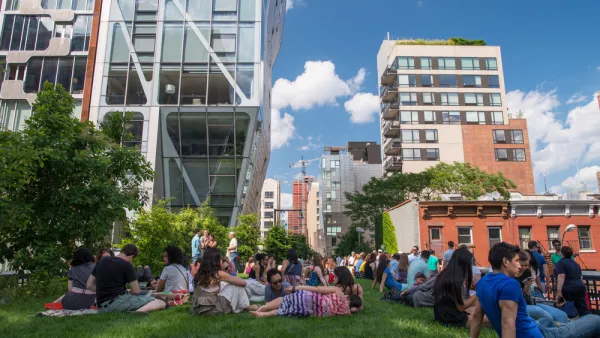The 10th anniversary and updating of Richard Florida's "Rise of the Creative Class" has brought about a re-evaluation of "creative class" urbanism. Will Doig surveys a series of popular essays that question Florida's highly influential arguments.
A flurry of articles in blogs and journals over the last couple of months have argued for the failings of different elements of creative class theory. The most recent of these, appearing in the literary journal The Baffler, "took aim at urbanism's fetish for 'vibrancy,' and called the coolness-will-save-us model a 'Ponzi scheme' that needs to be stopped," notes Doig.
He suggests there is a growing conversation, and concern, "that much of today's
urbanism, even when its goals are lofty, is too muddled with buzzwords,
corporate-speak and privileged points of view." While counter-arguments to Florida often dwell on semantics rather than substance, Doig argues that at the heart of the criticisms lies a spreading anxiety, "that
some of this stuff - the streetcars, the pop-up cafes, the activated
spaces, the 'vibrancy' - is frivolous and insubstantial."
And the fact that many of these dissenting articles appear in "small publications, written by people who aren't as invested in urbanism as a movement," Doig seems to argue, is their greatest credential. Planners, as a lot, are remiss if they aren't invariably suspicious of the type of sure-minded group-think that brought about the disastrous urban renewal schemes of the 1950s and 60s. And Doig seems to play on this suspicion by making an analogy between these articles and the work of "local activists" who by the mid 1960s, "had been writing for years in
community newspapers about the destructiveness of urban renewal
policies, that they were doing more harm than good."
"Meanwhile," Doig continues, "the New
York Times was still running
Op-Eds promoting 'the long-standing national goal of tearing down all
slums and providing every American family with ‘a safe, decent and
sanitary home.''
Because, "The Times, along with some of the brightest minds of that generation,
was wrong about cities," concludes Doig, "Some of the ideas that are being implemented [now]
might also be wrong..."
FULL STORY: Hipsters won’t save us

National Parks Layoffs Will Cause Communities to Lose Billions
Thousands of essential park workers were laid off this week, just before the busy spring break season.

Retro-silient?: America’s First “Eco-burb,” The Woodlands Turns 50
A master-planned community north of Houston offers lessons on green infrastructure and resilient design, but falls short of its founder’s lofty affordability and walkability goals.

Delivering for America Plan Will Downgrade Mail Service in at Least 49.5 Percent of Zip Codes
Republican and Democrat lawmakers criticize the plan for its disproportionate negative impact on rural communities.

Test News Post 1
This is a summary

Test News Headline 46
Test for the image on the front page.

Balancing Bombs and Butterflies: How the National Guard Protects a Rare Species
The National Guard at Fort Indiantown Gap uses GIS technology and land management strategies to balance military training with conservation efforts, ensuring the survival of the rare eastern regal fritillary butterfly.
Urban Design for Planners 1: Software Tools
This six-course series explores essential urban design concepts using open source software and equips planners with the tools they need to participate fully in the urban design process.
Planning for Universal Design
Learn the tools for implementing Universal Design in planning regulations.
EMC Planning Group, Inc.
Planetizen
Planetizen
Mpact (formerly Rail~Volution)
Great Falls Development Authority, Inc.
HUDs Office of Policy Development and Research
NYU Wagner Graduate School of Public Service




























